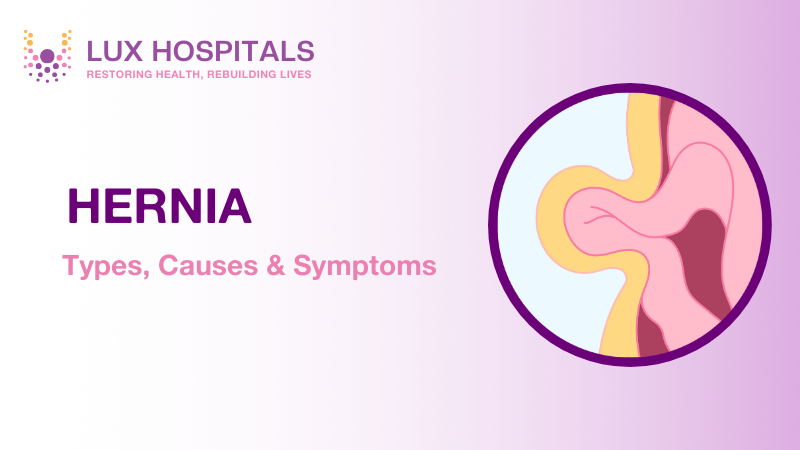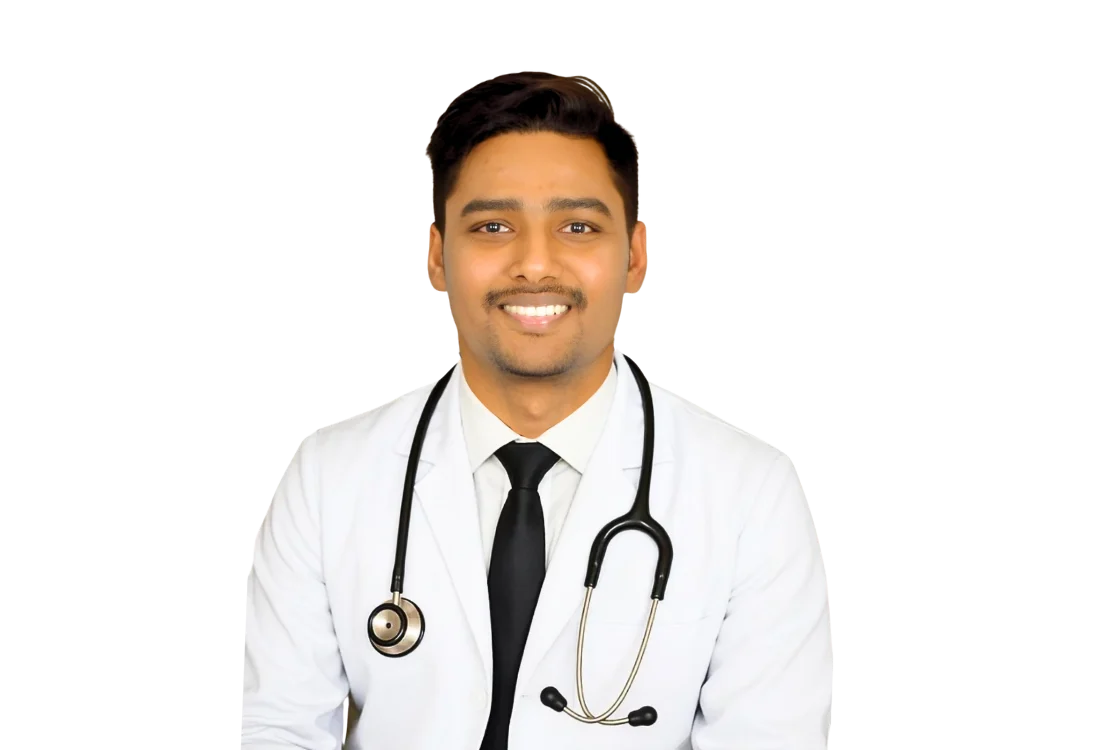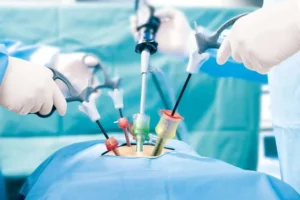Hernias: Types and Effective Treatment Options

Hernias are common and affect millions of people worldwide.They occur as a result of an internal organ or tissue pushing through a weak area in the surrounding connective tissue or muscle. While they may present themselves as a minor condition, untreated hernias can eventually lead to serious complications.
The knowledge of the types, causes, symptoms, and treatment options is important in the effective management and prevention of this ailment.
What Is a Hernia?
A hernia is a weak area or opening in the surrounding muscle or connective tissue that allows an organ or tissue to protrude. Although hernias can occur in any part of the body, the most common types are those found in the abdominal or groin area. Hernias may develop gradually or suddenly after specific events, such as heavy lifting or straining.
Types of Hernias
Hernias are categorized by location. The most common are the following:
Inguinal Hernia
This is the most common type and occurs when part of the intestine or fatty tissue squeezes into the groin through the inguinal canal. It is more common in men.
Femoral Hernia
Less common and more frequent in women, this type occurs when tissue protrudes through the femoral canal in the upper thigh. It’s more likely to happen during pregnancy or after giving birth.
Umbilical Hernia
This type is most common in infants but also occurs in adults, especially if they are overweight or have had multiple pregnancies. It is located near the belly button.
Hiatal Hernia
This occurs when a portion of the stomach goes into the chest through the diaphragm. It is commonly linked to GERD or gastroesophageal reflux disease.
Incisional Hernia
These are located at the location of a prior surgical procedure because of poor healing that has left a weak point in the abdominal wall.
Epigastric Hernia
Located in the upper abdomen, in between the belly button and chest, this is caused by muscle weakness.
Spigelian Hernia
A rare variety that occurs on the side of the abdominal wall, below the navel
Causes of Hernias
A combination of muscle strain and weakness usually causes hernias. Among the common causes are:
- Heavy lifting: Muscles are strained when heavy objects are lifted
- Chronic coughing: Continued coughing due to smoking, lung diseases etc. weakens the abdominal muscles
- Obesity: Extra body mass increases the pressure on the abdominal wall
- Pregnancy: The growing uterus puts strain on abdominal tissue.
- Constipation: When bowel movements are difficult, intra-abdominal pressure rises.
- Previous Surgery: Surgical scars may leave weak spots.
- Aging: Muscles weaken with age, making them more susceptible.
Identifying Symptoms
Hernia symptoms vary with the type and severity. The most common include:
- A bulge or swelling is visible in the affected area.
- Pain or discomfort, primarily at times when you cough, bend, or lift.
- Heaviness or pressure in the abdomen or groin area.
- Burning or aching around the hernia.
- In severe cases, nausea and vomiting.
- A hiatal hernia will present with heartburn and, in some, difficulty swallowing food.
If you experience these symptoms, it would be necessary to seek an expert’s opinion before complications arise.
Diagnosing Hernias
Diagnosing usually starts with a physical exam. Doctors will ask you to cough or strain as they check for bulges. Diagnostic imaging, like ultrasound or CT scans, may be used to diagnose the type and severity of the condition.
Treatment Options for Hernias
The treatment depends on the type and severity of the condition. Larger or symptomatic hernias usually require treatment, whereas small, asymptomatic hernias might not need to be treated right away. The options include:
1. Watchful Waiting
It could be advised to take a “watchful waiting” approach for minor, asymptomatic hernias. Frequent monitoring guarantees that the hernia won’t worsen. If symptoms appear, more care could be needed.
2. Lifestyle Changes
Some changes may provide relief from symptoms and can stop the hernias from getting worse:
- Avoid heavy lifting and straining
- Maintain a healthy weight
- Eat a high-fiber diet to avoid constipation
- Stop smoking to reduce coughing
3. Surgery
Surgery is often the most effective treatment for hernias, especially the larger or symptomatic ones. There are two major types of Surgery:
a. Open Surgery
This is done through a single large incision to push the tissue back into place and repair the muscle with stitches or mesh reinforcement.
b. Laparoscopic Surgery
This is a minimally invasive technique using small incisions and a camera (laparoscope) to guide the surgeon. Recovery time is usually shorter and less painful than open Surgery.
Both techniques are used to reinforce the weakened area to avoid recurrence. The decision lies with the type of hernia, its size, and your general health.
Surgical Risks and Complications
Like any other surgery, hernia surgery also involves some risks, including:
- Infection at the site of Surgery
- Bleeding
- Pain at the site of incision
- The recurrence of hernia
- Mesh-related complications, such as rejection or migration, though rare
These risks can be minimized by following the post-operative care guidelines.
Prevention of Hernias
While not all hernias can be prevented, you can reduce your risk with these measures:
- Lift properly: Use your legs, not your back, when lifting heavy items.
- Maintain a healthy weight: Avoid putting excess pressure on your abdominal wall.
- Eat foods high in fibre: Prevent constipation and straining.
- Exercise for a strong core: Regular exercises help strengthen muscles.
- Quit smoking: Reduce coughing and improve your overall health.
Recovery After Surgery
The recovery time will vary depending on the Surgery. Some general tips for recovery include:
- Rest: Avoid difficult tasks to speed up your recovery.
- Use supportive garments: For post-surgery assistance, follow your doctor’s advice.
- Manage pain: Take prescribed medications as directed.
- Watch for complications: Infection symptoms such as fever, edema, or redness should be monitored for.
- Gradual activity: Resume daily activities as advised by your doctor.
Conclusion
Hernias can dramatically influence daily life; however, there are effective treatments available. The key to not developing any complications is early diagnosis and intervention. Addressing a hernia quickly, whether with lifestyle changes or monitoring, provides relief and, consequently, increases the quality of life. Thus, if symptoms of a hernia arise, healthcare professionals should examine one for further diagnosis and a course of personalized treatment.
Frequently Asked Questions
The best treatment for a hernia is surgery, either open or laparoscopic, depending on the size and symptoms. Small, asymptomatic hernias may be managed with watchful waiting and lifestyle changes.
If left untreated, a hernia can lead to complications such as pain, discomfort, and the risk of strangulation, where the blood supply to the herniated tissue is cut off. This can lead to tissue damage, infection, and other serious health issues. It’s important to seek treatment to prevent these risks.
The main cause of a hernia is a combination of muscle weakness and increased pressure, often from heavy lifting, chronic coughing, obesity, pregnancy, or aging.
The five warning signs of a hernia include a visible bulge, pain or discomfort when bending or lifting, heaviness in the abdomen or groin, burning or aching sensations, and in severe cases, nausea or vomiting.
For hernia diagnosis and treatment, you should see a general surgeon. Lux Hospitals has experienced general surgeons with the best expertise in hernia care, ensuring effective treatment and recovery.




















